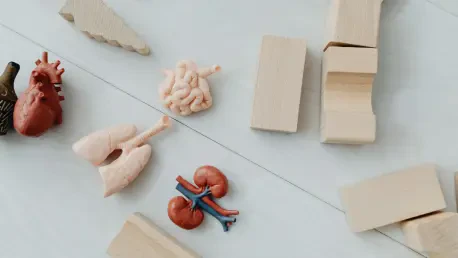In the intricate world of pediatric medicine, diagnosing pulmonary nodules presents a formidable challenge that keeps clinicians on edge, as these small, round opacities on chest imaging can signify anything from harmless conditions to rare but serious malignancies. For children, the stakes are uniquely high—missing a cancerous nodule could lead to devastating outcomes, while misinterpreting a benign finding might result in unnecessary stress, radiation exposure, or invasive procedures. The complexity is compounded by the fact that, unlike in adults, pediatric nodules are more often tied to infections or inflammation rather than cancer, yet the risk of misdiagnosis looms large. Fortunately, artificial intelligence (AI) is emerging as a transformative force in this field, offering unprecedented precision and efficiency in identifying and managing these nodules. This technology promises to ease the burden on healthcare providers and bring reassurance to families by enhancing diagnostic accuracy, paving the way for a new era in pediatric radiology where timely and accurate decisions can save lives.
Revolutionizing Detection with Artificial Intelligence
Artificial intelligence is rapidly becoming a cornerstone in pediatric pulmonary care, fundamentally changing how nodules are detected and interpreted. Machine learning algorithms, honed on extensive collections of imaging data, excel at identifying subtle nuances in nodule characteristics—such as size, shape, and growth patterns—that might be missed by even the most seasoned radiologists. This capability translates into significantly improved diagnostic accuracy, allowing for earlier identification of potential issues. In a field where every moment counts, especially for young patients who may need urgent intervention, AI’s ability to slash interpretation time is invaluable. By providing rapid insights, this technology ensures that clinicians can act swiftly, whether to rule out malignancy or to initiate treatment, ultimately enhancing patient outcomes in high-stakes scenarios.
Beyond speed, AI serves as a dependable partner in reducing human error, acting as an unbiased second opinion in complex cases. For example, tracking minute changes in a nodule’s growth over time—a critical indicator of whether it might be cancerous—becomes far more manageable with AI’s analytical strength. This consistency is particularly beneficial in pediatric settings, where variability in imaging interpretation can lead to divergent treatment paths. By offering data-driven insights, AI empowers healthcare professionals to make decisions with greater confidence, minimizing the risk of overlooking critical details or overreacting to benign findings. The result is a more streamlined diagnostic process that prioritizes the well-being of young patients while supporting doctors in navigating the intricate landscape of pulmonary nodule management.
Navigating the Obstacles of AI Adoption
Despite its potential, integrating AI into pediatric pulmonary diagnosis is not without significant challenges that must be addressed to ensure equitable care. A primary concern lies in the quality and diversity of the data used to train these systems. If the datasets lack representation—perhaps missing images across varied age groups, ethnicities, or socioeconomic backgrounds—the resulting algorithms risk producing biased or inaccurate predictions. In pediatrics, where physiological differences are pronounced, such shortcomings could lead to disparities in diagnosis and treatment. This issue highlights the urgent need for comprehensive data collection that mirrors the diversity of the patient population, ensuring that AI tools are reliable for every child, regardless of their background or circumstances.
Another hurdle is the rigorous validation required to make AI systems trustworthy in clinical settings. Validation across diverse demographics is essential to confirm that these tools perform consistently and fairly, avoiding scenarios where certain groups might receive suboptimal care due to algorithmic blind spots. Additionally, there’s the challenge of integrating AI into existing workflows without disrupting the human element of medicine. Clinicians must be trained to use these tools effectively, understanding their limitations and ensuring that technology complements rather than overrides clinical judgment. Addressing these obstacles through robust research, policy development, and education will be critical to unlocking AI’s full potential in transforming pediatric pulmonary care, making sure that innovation serves as a bridge to better health outcomes for all.
Enhancing Access through Telemedicine
Telemedicine is emerging as a vital ally in the quest to improve pediatric pulmonary nodule diagnosis, particularly by expanding access to specialized care. With telehealth platforms, medical professionals can instantly share imaging results and consult with experts in real time, a development that proves invaluable for families in remote or underserved regions. A pediatrician in a rural clinic, for instance, can now connect with a top radiologist or oncologist located miles away, ensuring that children receive expert input without the burden of long-distance travel. This connectivity not only accelerates decision-making but also democratizes access to high-quality care, breaking down geographic and economic barriers that have historically limited health equity.
Moreover, telemedicine complements AI by facilitating the rapid dissemination of AI-generated insights across clinical teams. When an AI system flags a concerning nodule, telehealth enables immediate discussion among specialists, allowing for collaborative interpretation and planning. This synergy ensures that technology and human expertise work hand in hand to deliver timely interventions. For families, the impact is profound—knowing that their child’s case is being reviewed by a network of experts provides reassurance during uncertain times. As telemedicine continues to evolve, its role in pediatric care will likely expand, further bridging gaps and ensuring that advanced diagnostics, bolstered by AI, reach even the most isolated communities with speed and precision.
Fostering Interdisciplinary Synergy
The management of pediatric pulmonary nodules increasingly relies on interdisciplinary collaboration, uniting diverse expertise to create comprehensive care strategies. Radiologists, pediatricians, oncologists, respiratory specialists, and AI developers are joining forces to ensure that technological advancements are grounded in clinical realities. This teamwork is essential because children present unique medical needs—their biology, disease progression, and responses to treatment differ markedly from adults. By pooling knowledge, these professionals can tailor diagnostic and therapeutic approaches, ensuring that AI tools are adapted to address the specific challenges of pediatric cases rather than simply applying adult-centric models.
This collaborative spirit also drives innovation in how care is delivered, with each specialty contributing unique perspectives to refine AI applications and treatment protocols. For instance, while radiologists interpret imaging data, AI specialists fine-tune algorithms for greater accuracy, and clinicians provide insights into patient histories that contextualize findings. The result is a holistic framework where technology supports personalized care plans, addressing not just the nodule itself but the child’s overall health and circumstances. Such synergy minimizes the risk of misdiagnosis and overtreatment, fostering a balanced approach that prioritizes safety and efficacy in every decision made for young patients.
Envisioning a Future of Tailored Innovation
Looking ahead, the integration of AI and digital tools into pediatric pulmonary care appears set to deepen, promising a future of even greater precision and adaptability. As electronic health records and advanced imaging technologies become more sophisticated, AI algorithms are expected to evolve, offering increasingly nuanced analyses of pulmonary nodules. However, a key focus remains on pediatric-specific research to ensure these tools are finely tuned to the distinct needs of children. Diseases manifest differently in younger patients, and their responses to diagnostic and therapeutic interventions vary, necessitating dedicated studies to recalibrate AI systems that may have originally been designed for adult populations.
Equally important is the push for standardized guidelines that can harmonize the use of AI and other technologies in clinical practice. Variability in current approaches to nodule management often leads to inconsistent outcomes, underscoring the need for evidence-based protocols tailored to pediatric contexts. By investing in research and policy development over the coming years, the medical community can build a robust framework where AI serves as a reliable partner in diagnosis. This vision of a tech-driven future holds the potential to transform pediatric pulmonary care, ensuring that every child benefits from swift, accurate assessments and individualized treatment plans crafted with cutting-edge innovation and compassionate expertise.









